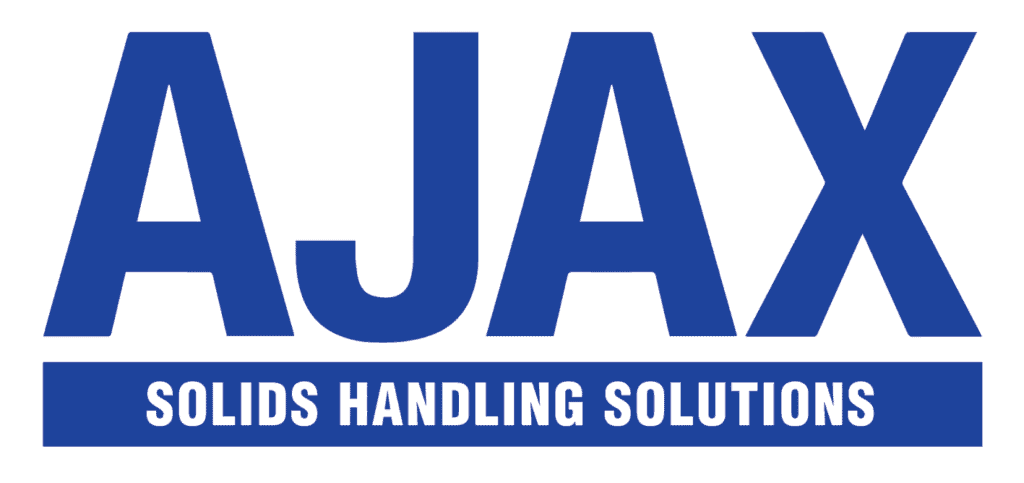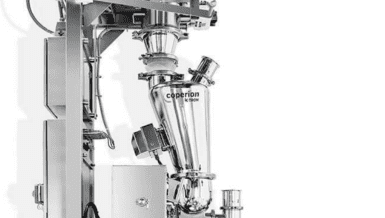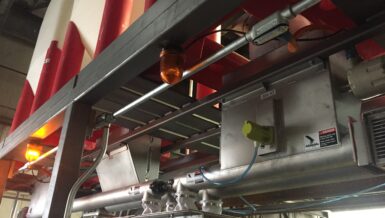Bulk material falling into a hopper during the loading process tends to land in a dilated state and then settle down to a more compact condition as excess air escapes from the voids. This process takes place quickly with large granular material, but can take some time with fine particulate products. Meanwhile, pressure of air in the voids supports part of the weight of material in the hopper until the pressure declines to ambient. Any slip on vertical walls during settlement mobilises frictional resistance on the hopper walls and create ‘stressed arches’ in the bulk that reduce vertical pressures. Screw and belt feeders shear the hopper contents by causing the product to axially transfer the material to a side outlet. However, the vertical load on the outlet region and consolidation with settlement gives rise to a packed condition that can be very difficult to shear, especially on an initial start following the loading of a hopper from empty.
This is for three reasons,
- Physical overlap of particles. Settled granular materials develop support from frictional resistance of boundary walls and the vertical components of force acting at points of contact. Since settled particles nest in a close array, a horizontal shear force must overcome the frictional resistance of contacts to expand the bed sufficient for particles to pass each other. Flowing bulk materials therefore occupy more space than when settled. Expansion to flow can only be provided in a confined bed by an equivalent local compaction, which can be strongly resisted by a firm structure. Although the expansion required is quite small, the static stress resistance in a confined mass can be very large. Note: – This is distinct from the special case of interlocking fibrous materials that become entangled, analogous to what can happens with stored coat hangers in a box. These shear surfaces oppose separation by overlapping friction or tensile failure of the trapped fibers and are special cases.
- Fine powders dilate in free fall during hopper loading or when delivered by a pneumatic conveyor. The dilate state may take a considerable time to settle to a stable condition as the porosity and the void pressure differential to ambient both reduce exponentially. Shear expansion when starting the extraction from a settled condition creates a reduction in the void pressure. This resists expansion equivalent to an applied external load. This component of flow resistance ceases when flow has developed.
- During the filling of a hopper the weight of material acts vertically to give high compacting pressures until flow takes place. These vertical loads then ‘switch’ to the minimum principle stress of a ‘stressed arch’ that develops between the flow boundaries once frictional resistance is mobilised. The confined compacting force is reduced by the supporting forces and shear can take place easier in the expanded flow condition.
All these phenomena are of short duration, if the drive is sufficient to overcome their intensity. However, their magnitude may be many times the force required to sustain the normal running load when flow has developed has developed, and may stall the drive indefinitely. Fitting a larger drive to accommodate high starting loads results in higher capital cost and inefficient operational for nearly all the long working life of the equipment. Starting problems can have serious financial and production implications, so it is important to ensure that the outlet size of a hopper should not radically exceed the ‘critical outlet span’. A factor of safety must be allowed for exceptional material conditions or operating variations, but specifications should be based on wall friction and shear tests as power requirements increase roughly as the square of the increase over the critical arching span.
The value of this force is sensitive to the size and strength of the constituent
particles and the passive strength of the material. These features are more important than the density of the material and independent of the scale of the equipment. Measurement of this force could be established in a shear cell of a depth that takes account of the particle size of the test material, provided the lid is loaded to represent the filling conditions and is confined to prevent expansion of the sample.
This highest load condition applies only on the first time that the feeder is started after being loading from empty as the stressed arch condition is retained as the material is brought to rest. These high starting loads can be countered with granular material by running the feeder for a very short period at a very early state of filling an empty hopper. This will develop a stressed arch flow condition with light overpressures that are sustained for when it the feeder is restarted at higher bin levels. The duration of such a ‘protective’ start can be very short, probable not adequate to discharge any material from a screw feeder that is loaded from empty, as the material moved will be retained in the short casing section of the feeder between the hopper exit and the screw or belt discharge point. During further operation a ‘heel’ of material should be restained in the hopper, to secure a similar condition for subsequent re-starts.
An alternative, or complementary technique, is to provide local expansion space for the material near the hopper outlet. This can be done by fitting a hopper insert close to the outlet. An inverted ‘V’ type will form two flow channels that, with careful design, also improves the flow form of the hopper and shields the outlet from direct overpressures, whilst providing a local void for expansion of the bulk. An alternative method is to offset the feeder from the outlet and collect from the hopper by taking material from the end of the repose slope.
These suggestions are particularly relevant to coarse granular materials. Initial shear of a fine powder that is well settled tends to be resisted by the void demand for ambient air to satisfy the increasing void volume. These conditions will apply each time the feeder is starter after a period of standing. Starting a feeder during the loading of a hopper risks initiating ‘flushing’ as free fall conditions during filling of the hopper, or shortly after, could develop a loose flow path though the feeder of the dilated material.
Good practice is not to start a feeder shortly after loading a fine product, but allow time for the material to settle to a stable condition. Restarting a settled product places an air demand in the expanding shear layer.
In some cases a local route by which air can travel to and from ambient is adequate to de-aerate a fluid bulk material and satisfy the air demand on re-start of a settled product. A short injection of air above the outlet immediately on starting will ease the starting load in three ways:
- By relieving the compacting pressure,
- Applying a pressure to material towards the outlet and,
- Providing air to satisfy the expanding shear layer.
In more serious cases, due to such as extensive storage times, a continuous air injection at a comparatively small rate can be injected, starting a short period after loading. This is to replace air escaping from the hopper contents before it settles to a firm condition Air supplied should be dry, to avoid adding moisture to the inlet region.
As before, running the feeder for a short period at an early stage of loading the hopper will develop a flow condition and creates the ‘stressed arch’ in the hopper contents and reduces the pressure acting on the outlet, making it is easier to shear. The run period can be very short and is only relevant for occasions where filling takes place to an empty hopper, or if the contents have been static for a long period.
Like many problems in solids handling, brute force is not a good answer and a much better approach is to exploit the technology and basic engineering principles.










































